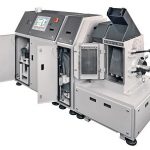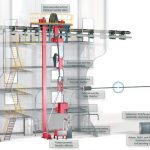AMP, the automatic milling and pressing system, was presented by Siebtechnik at Powtech 2013. In an interview with cpp Jens Corell, Head of Technology at Siebtechnik GmbH, explains how this system simplifies the preparation of solid samples and describes the accessories it can be combined with.
Author Lukas Lehmann Assistant Editor-in-Chief
cpp: Mr. Corell, what do we need the AMP system for?
Corell: This system allows solid samples to be prepared as test specimens for XRF and XRD analysis. These two analysis methods are used to determine the structure of solids by means of X-rays.
cpp: Could you describe the design of the system?
Corell: It basically comprises a dosage unit, a vibrating disc mill, a tablet press with integrated tablet testing and a cleaning unit. An MT module, comprising a jaw crusher and divider, can also be connected to the system upstream.
cpp: That doesn’t come with the AMP system as standard, though?
Corell: Correct. But we do recommend combining the AMP system with the BT module to enable lumpy, solid samples – which usually have a granular size from 100 to 150 mm – to be comminuted to analysis fineness in one compact system and subsequently pressed to obtain a test specimen. The samples would otherwise have to be precrushed in a separate jaw crusher, then divided and fed to a cone crusher for secondary crushing. Only then would they be the right size for further processing in the AMP system with its vibrating disc mill.
cpp: Does that mean secondary crushing in the cone crusher is eliminated?
Corell: Due to the fact that our jaw crusher achieves a reduction ratio of 1 : 100, the granular size of the sample is less than 2 mm after passing through, with the result that secondary crushing in the cone crusher is no longer necessary.
cpp: Once the sample has passed the BT module, it arrives in the AMP system’s dosage unit. What happens there?
Corell: The operator determines how many test specimens he or she wants to generate from the primary sample. Based on these parameters, the dosage unit carries out volumetric separation of the partial quantities.
cpp: When are the grinding aids dosed?
Corell: Upstream of the vibrating disc mill. Another dosage unit located there is responsible for dosing the grinding and pressing aids.
cpp: That takes us to the next component of the AMP system, the vibrating disc mill. How does that work?
Corell: This mill comprises a grinding vessel containing a grinding body. Both are made of tungsten carbide. An unbalanced motor sets the grinding vessel in a tumbling motion. This motion causes the bulk material sample between the grinding body and the wall of the grinding vessel to be comminuted by a combined shearing and impact load. Granular sizes from 2 to 100 µm can be obtained by varying the grinding duration and the vibration of the grinding vessel as a function of the sample material properties.
cpp: How does the ground sample get from the mill to the press?
Corell: The side walls of the grinding vessel are automatically raised after the set grinding time. The vessel continues to vibrate, so that the solid powder drops into a container. From there, it is fed to the press via a flexible pipeline. When it arrives at the press, the powder is pressed in a sample ring to form a tablet. This tablet subsequently passes through a testing device to verify its me-chanical stability.
cpp: Why is this test important?
Corell: It ensures that the tablets have a certain solidity and do not break during the analysis. Broken tablets would contaminate the measuring chamber and necessitate costly cleaning.
cpp: What pressure does the hydropneumatic press reach?
Corell: A maximum of 187 kN. However, this pressure – just like the holding and expansion time – depends on the extent to which the sample is to be compacted. Both these parameters can be set on the system’s touch screen.
cpp: You mentioned the cleaning unit as another component. When is it used?
Corell: After each grinding and pressing process, it cleans the parts in contact with the product fully automatically to prevent the samples from being mixed. It comprises compressed air nozzles and extraction devices installed at various points in the AMP system and, if necessary, the BT module.
cpp: What output does the AMP system achieve?
Corell: Up to 10 tablets an hour.
cpp: When does it make sense to purchase it?
Corell: The principal customers for the AMP system are laboratories that carry out a large number of tests, such as central laboratories in the chemical industry and particularly at fertiliser manufacturers, who use it for routine analytics.
cpp: What benefits does the AMP system offer users?
Corell: Three process steps – dosing, grinding and pressing – take place fully automatically in one very compact system. On the one hand, this reduces the amount of manual labour. On the other, the system permits more reliable analyses because it minimises the risk of individual errors in the production of test specimens for XRF and XRD.
cpp: Siebtechnik also offers pneumatic tube systems in addition to AMP. What function do they have?
Corell: They transport the solid bulk samples from the sampling point to the laboratory, where our AMP system, say, is installed. This work otherwise has to be carried out by mes-sengers, who ride around the facility on a bicycle or by car collecting the bulk material samples and delivering them to the central laboratory. These staff are now available for other assignments. Another advantage is that transport in the pneumatic tube system can be documented, so that the entire process from sampling to analysis is completely traceable.
cpp: How is the pneumatic tube system designed?
Corell: In the simplest scenario, the system comprises a sending and a receiving station, a tube 80 mm in diameter, several carriers and one or more side channel blowers which provide the feed air. Their number depends on the conveying distance.
cpp: Which materials are used to make the individual components?
Corell: The carriers are made of plastic because they need to be as light as possible. Apart from that, all components in contact with the product are made of stainless steel. We produce the housing sections in conventional steel.
cpp: How does the solid bulk sample get into the carrier?
Corell: This can be done manually or automatically depending on each user’s requirements. The same applies to the configuration of the sending station and operation of the receiving station. A fully automatic pneumatic tube system is naturally the most effective. The empty carriers are removed from the tube, opened, fed to a filling station and closed again without human help before being loaded in the sending station and unloaded in the receiving station. The carriers are also opened, emptied and cleaned automatically in the receiving station, of course.
cpp: Is it also possible to connect several sampling points to the system?
Corell: You can do that using tube diverters. Up to four sending stations can be connected to each receiving station with one diverter. Gear motors take care of setting the diverter positions.
cpp: We talked about the AMP and pneumatic tube systems. Does Siebtechnik also have sampling systems in its product range?
Corell: Yes, we have several different systems for representative sampling from vertical downpipes or conveyors in our range. There are also various systems for sample preparation such as crushers, mills and sample dividers. Customers can either purchase these highly diverse components from us individually or use us as a system provider for sampling and sample preparation.
cpp-net.com/0114401
Share:









